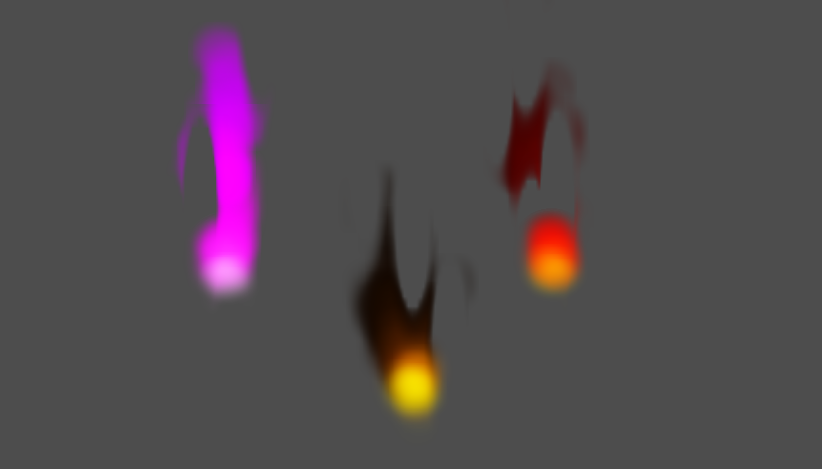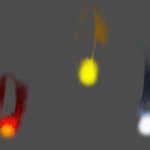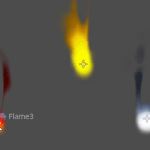2D Flame
Very much inspired by https://x.com/minionsart/status/1132593681452683264
The smoothstep limits are just magic numbers, I just tweaked them until the flame looked good enough. Feel free to change them if you’re curious 🙂
Setup:
- This shader should be applied to the material of a GPUParticles2D node.
- You have to ensure that the particles are quads that are big enough (I used 30×30).
- For the noise texture, I used cellular noise 1 octave and 0.04 frequency. Everything else for the noise was just the default.
- You will need the following script on the GPUParticles2D node:
@tool extends GPUParticles2D func _process(_delta): material.set_shader_parameter("origin", global_position) - It’s probably easiest to just look at the demo project for how to set it up.
To make multiple flames, you have to right click on the material and “Make unique”
Shader code
shader_type canvas_item;
render_mode world_vertex_coords;
// Copyright (c) 2024 Embla Flatlandsmo
//
// This file is licensed under the MIT License.
// You can find a copy of the license at
// https://opensource.org/license/MIT
uniform sampler2D noise;
uniform float offset_speed_multiplier: hint_range(0.0, 5.0) = 2.0f;
uniform vec3 flame_color: source_color = vec3(0.525, 0.35, 0.0);
uniform vec2 bounds_size = vec2(100);
uniform vec2 origin;
uniform float core_flame_radius = 1.0;
varying float particle_lifetime_phase;
varying vec2 instance_pos;
varying vec2 local_vert_pos;
void vertex() {
// From https://docs.godotengine.org/en/stable/tutorials/shaders/shader_reference/canvas_item_shader.html:
// INSTANCE_CUSTOM.y is phase during particle lifetime (0 to 1).
particle_lifetime_phase = INSTANCE_CUSTOM.y;
local_vert_pos = VERTEX;
}
float core_flame_alpha(vec2 uv)
{
// Calculates the alpha for the circle at the base of the flame
return smoothstep(0.75, 1.0, core_flame_radius-distance(vec2(0.5), uv))*0.2;
}
float calculate_ellipsis_alpha(vec2 uv)
{
// The ellipsis is part of the flame trail
vec2 uv_with_offset = uv - vec2(0.5,0.0);
// Create the main ellipsis shape
float ellipsis_alpha = 1.0-smoothstep(0.2, 0.9, distance(vec2(2.0, 0.5)*uv_with_offset, vec2(0.0)));
// Make the ellipsis more transparent the further up we get.
ellipsis_alpha *= smoothstep(-1.25, 0.5, uv_with_offset.y);
return clamp(ellipsis_alpha, 0.0, 1.0);
}
float noise_texture_alpha(vec2 uv)
{
// The noise texture is part of the flame trail.
// First, scale the UV coordinates down:
const float tex_coord_scaling = 0.2f;
vec2 tex_coord = uv*tex_coord_scaling;
// Scroll over the texture with time
tex_coord.y += TIME*offset_speed_multiplier*tex_coord_scaling;
// Repeat the texture if it goes out of bounds.
vec2 max_tex_coord = vec2(1.0);
tex_coord = modf(tex_coord, max_tex_coord);
return texture(noise, tex_coord).a;
}
float quad_alpha_falloff(vec2 uv)
{
// Creates a circle with soft edges for a quad
return smoothstep(0.4, 0.8, 1.0-distance(vec2(0.5), uv));
}
void fragment() {
// Center the UV coordinates about the emitter's global position.
// The bounds_size defines the global bounds for the UV coordinates.
vec2 tex_coord = (local_vert_pos-origin+bounds_size/2.0)/(bounds_size);
COLOR.a = calculate_ellipsis_alpha(tex_coord) * noise_texture_alpha(tex_coord) * particle_lifetime_phase + core_flame_alpha(tex_coord);
// Turn each particle into a soft dot rather than a square.
COLOR.a *= quad_alpha_falloff(UV);
COLOR.rgb = flame_color;
// The classic color dodge formula: (B/(1-A))
COLOR.rgb /= (1.0-smoothstep(0.5, 0.0, particle_lifetime_phase));
}







